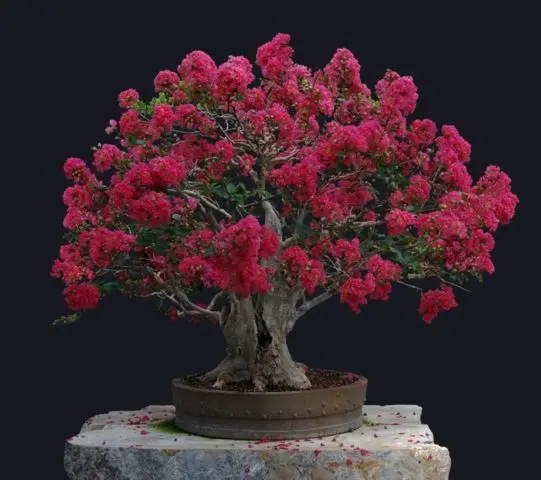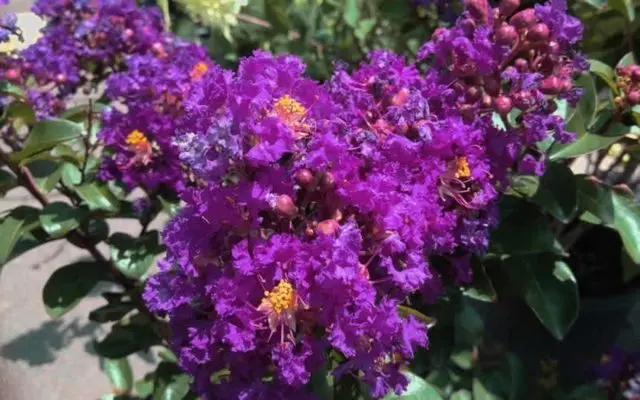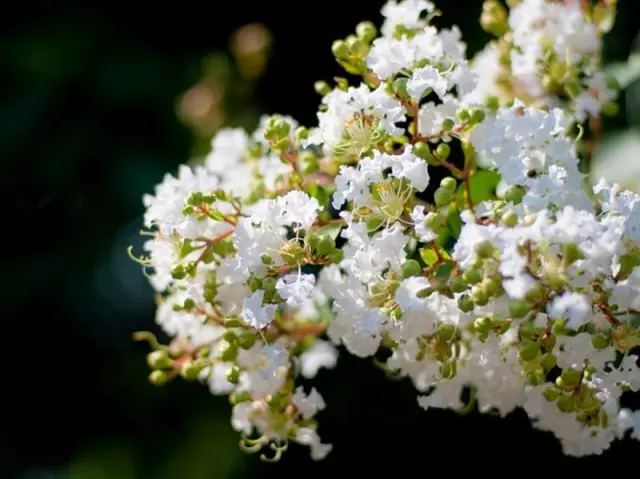Contents
The genus of flowering shrubs Lagerstroemia (Lagorstroemia) includes approximately 25 species of plants. Indian lilac is a prominent representative of the genus. This culture is whimsical, greenhouse, requires attention and good care. Compliance with all the rules of cultivation will ensure abundant and long flowering.
Description of the Indian lilac lagerstroemia
The height of a shrub or tree depends on growing conditions. In the wild, the plant reaches 11 m in height, in room conditions it does not exceed 1 m. The crown of a wild crop can reach 8 m.
Lagerstromia in the form of a shrub produces many straight thin shoots covered with light brown bark. The tree has a single thin but strong trunk, the color of the bark is light, gray-brown.
The leaves are oblong, dark green, elliptical in shape. The tips of the leaves are pointed, the edge is almost even. The length of the leaf ranges from 3 to 6 cm. In autumn, the leaves turn yellow and bright red.
Lagerstromia flowers are small, do not exceed 2 cm, collected in large, lush inflorescences, their length can reach up to 20-25 cm. The buds are formed from buds, which are more like small berries. The petals have an uneven wavy edge. The color range is extensive: pink, purple, lilac, white, there are also buds of different shades on the same tree. On the network you can find a photo showing this phenomenon of flowering Indian lilacs.
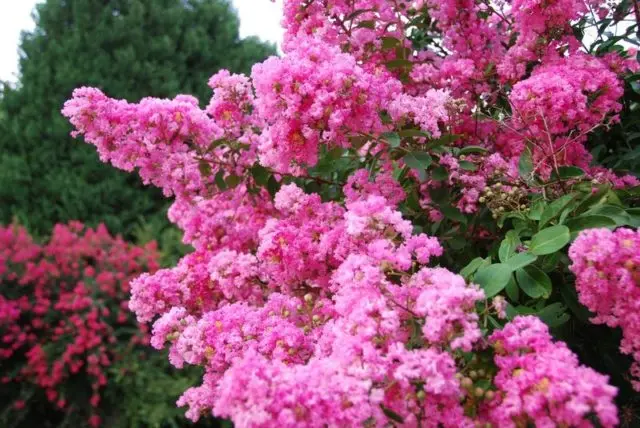
When and how does the Indian lilac bloom?
The beginning of flowering of lagerstromia occurs in July, the end – in October. During the day, as the buds open, their color also changes. On one shrub you can find lilac and dark purple flowers or pale pink and bright red.
Distribution area
The plant came to India from China, and then the culture was brought to Europe. Currently, a flowering tree can be seen on the streets of Asia, the Mediterranean, North and South America, and Australia. The plant also takes root well in the southern regions of Our Country and Ukraine.
Species and varieties
Of the 25 known species of Indian Lagerstromia, there are several that are easy to cultivate and can be grown even in the backyard.
These types of Indian lilacs include:
- Lagerstroemia blooms profusely (Lagerstroemiafloribunda), a plant that can be shaped into a tree or shrub. At home, you can grow bonsai or indoor lilac – lagerstroemia. The culture is characterized by abundant and long flowering. The petals are pink in spring and turn white in autumn. During the flowering period on one tree you can find all shades of pink, white, purple flowers.

- Lagerstroemia superb(Lagerstroemiaexcelsa) is a tall, up to 30 m tall, flowering tree. The trunk and branches are covered with smooth, glossy gray bark. During the flowering period, it produces small (up to 4 cm in diameter) dark purple buds.

- Lagerstroemia caudate (Lagerstroemiacaudata) grows to 20 m or more in height. Flowering is abundant and long from April to October. The flowers are about 3 cm in diameter, the color of the petals is white.

- Varieties of Indian lilac – RedFilly, CoralFilly, Violette Filli are winter-hardy types of Indian lagerstroemia. These are miniature, ornamental shrubs, the height of which does not exceed 50 cm, tolerate frosts down to -30 ᵒС. Flowering is long, up to 3 months. The root system of plants is not affected by low temperatures.

At home or on the street in tubs, lagerstromia is grown everywhere, for the winter they are removed to a heated room.
Where is Indian lilac used
Lagerstromia is used for landscaping gardens, parks, squares in the southern and coastal regions. Indian lilac is also grown as a home ornamental plant.
In oriental medicine, lagerstromia flowers are used to normalize blood pressure, lower cholesterol, and for weight loss.
In construction, a strong trunk of a flowering tree is used for the production of carpentry.
Growing Indian Lilac Lagerstroemia from Seeds
At home, a flowering tree can be grown in any region of Our Country. The easiest way to cultivate lagerstroemia is from seeds. A tall tree will not work, but you can try to grow a flowering, ornamental shrub.
When to plant
2 times a year – in autumn and spring, you can sow seeds of Indian lilac. It is important to create the correct temperature regime: + 10-13 ᵒС. Seeds are sown in greenhouses or on a windowsill in seedling containers.
Tank selection and soil preparation
For sowing, I use a universal ready-made soil for ornamental and flowering plants. You can independently prepare such a soil mixture: peat, sand, garden soil, leaf humus. All components are taken in equal parts.
Important! For planting, use plastic shallow containers for seedlings or peat cups.
How to plant Indian lilac seeds
Lagerstromia seeds are quite large, but light, they are embedded in prepared furrows to a depth of 2,5 cm and at a distance of 5 cm from each other.
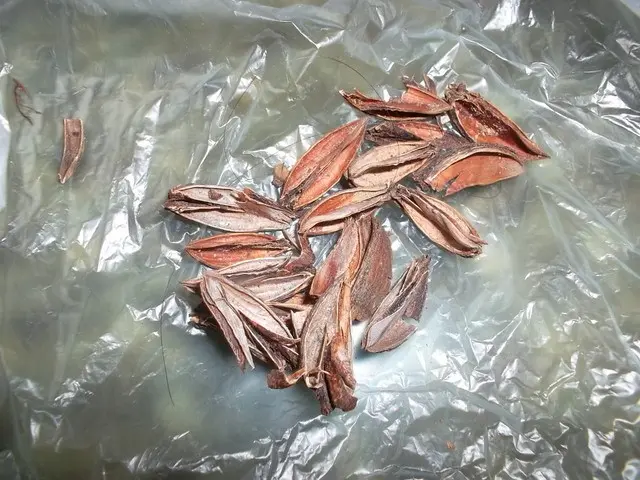
From above, the seedlings are sprinkled with a thin layer of grated soil without lumps or sand. Then the seeds are moistened with a spray bottle, covered with a film and placed in a well-lit place for germination.
How to look after
Before the emergence of seedlings of the Indian lilac (about 2 weeks), the plant is watered at home as needed. Every day, seedlings are aired for half an hour, removing the film from the container.
After the appearance of 2 true leaves, the grown seedlings are seated in separate containers. They are filled with the same soil as when sowing seeds. Before transferring seedlings to a permanent place (end of May and June), it is simply watered as needed.
Growing Indian lilacs outdoors
Lagerstromia seedlings are planted in the garden at least 1 year old. For planting choose a sunny warm place with light soil.
Terms of planting
Lagerstemia is planted in open ground at the end of May or at the beginning of June; this culture wakes up quite late in the spring. Until July, the May lilac will take root and quickly grow. The height of such a seedling by the middle of summer will be 1-2 m.
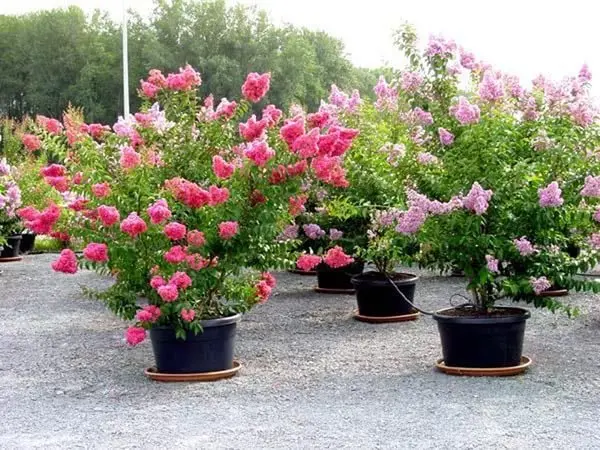
Site selection and preparation of soil
Indian lilac feels great in open areas under the scorching sun. Where other southern crops cannot grow, their leaves will burn, you can plant lagerstroemia.
Heavy chernozems are not suitable for growing May lilacs. She needs light, water- and breathable soil. To do this, any available soil 1: 1 is mixed with sand, dug well and loosened. Immediately before planting, the soil is well moistened.
Also for planting, you can choose areas with clay and loamy soil. On fertile, dense soil, Lagerstromia will grow well, but only shoots will develop, and flowering will remain weak.
Planting Indian lilacs in open ground
For transplantation, strong grown seedlings with a well-developed root system are chosen. When transferring a plant, you need to save an earthen room.

Landing technology:
- Landing pits are dug with a size of 50×50 cm.
- A layer of expanded clay is laid at the bottom for good drainage, a layer of peat is poured on top.
- The soil for planting is prepared by mixing garden soil, sand, peat and turf in equal parts.
- Sprinkle the root of the plant with this soil mixture after fixing it in the planting hole.
- After planting, the soil is gently trampled down, lagerstromia is watered abundantly.
In the first year after the rooting of the Indian lilac, no fertilizer is applied on the site. This will allow her to develop a strong root system. Fertilize the crop for the next year. This will stimulate the growth of new shoots and the formation of buds.
Care instructions
Lagerstroemia is watered frequently, about every other day. Good hydration is the key to abundant flowering culture. After watering, as soon as moisture is absorbed, the soil is loosened. Lagerstromia prefers to grow on light, breathable soils. If you need to keep moisture at the root for a long period, the soil is mulched. After watering, they fall asleep with a thick layer of sawdust or hay.
In spring and summer, watering is combined with top dressing. For this, complex mineral fertilizers are used. Top dressing is carried out 2 times a month, from May to August.

Lagerstromia is a fast growing and branching plant. If the shoots are not shortened once a year, the culture will grow and stop blooming, since inflorescences form only on young shoots. To stimulate their appearance, in the fall, at the end of flowering, or in the spring, in March, before the formation of buds, Indian lilacs are pruned. Remove old shoots, shortening them by a third. Leave about 20-30 cm of total length. If the task is to form a tree, one central long shoot is left, the rest are shortened. If you need to form a shrub, all shoots are cut equally.
Preparation for winter
If the Indian lilac grows in a tub, it is removed for the winter in a cool, dark room. The air temperature should not exceed + 15 ᵒС. Watering in winter is carried out once a month.

Plants rooted in the open ground are cut well in autumn, leaving shoots no longer than 20-30 cm. Frosts up to -10 ᵒС Indian lilac will endure painlessly if you cover it for the winter with a thick layer of spruce branches. In high lagerstromia in the form of a tree, only the lower part of the trunk is insulated. If the thermometer drops below -15 ᵒС, the ground part of the plant may die. In the spring, new shoots will appear from the rhizome, their flowering will be no less plentiful than the previous ones.
Diseases and pests
Indian lilac is resistant to most known garden pests and diseases. All this thanks to the thick, strong bark. With improper care, excessive shading and an excess of moisture, powdery mildew may appear on the leaves. In this case, the affected tree is pollinated with ash or sprayed with a solution of “Fundazol” or another fungicide.
On soils with an excess of alkali, Indian lilac leaves may turn yellow, chlorosis appears. To remedy the situation, the soil is dug deep in the fall with the addition of granulated sulfur or gypsum.
Spider mites and aphids can attack young seedlings of Lagerstromia growing in open ground. A shrub or tree should be sprayed with preparations from garden pests.
Application in landscape design
A high lagerstromia in the form of a tree looks great solo on any personal plot, in a park or alley. Indian lilac in the form of a shrub goes well with ferns, low coniferous crops. Lagerstromia is always best placed in the center of a flower bed or composition, surrounded by evergreen, non-flowering plants.
Indian lilac, like the European one, is good to plant near the house. When European lilacs bloom in spring, Lagerstromia will bloom in June. In this case, the lush flowering of two types of lilacs can be enjoyed from late April to September.
Indian lilac looks good against the background of any buildings, in any style. From the photo, you can choose how best to fit the Indian lilac – lagerstromia into the landscape.

This blooming culture blends well into both the countryside and the urban landscape. It looks equally good both against the background of banks, administrative buildings, and against the backdrop of summer cottages, rural houses.

Bush lagerstromia can also be planted in central Our Country in cities and rural areas. The main condition for good growth and lush flowering of ornamental culture is warming before the onset of frost.
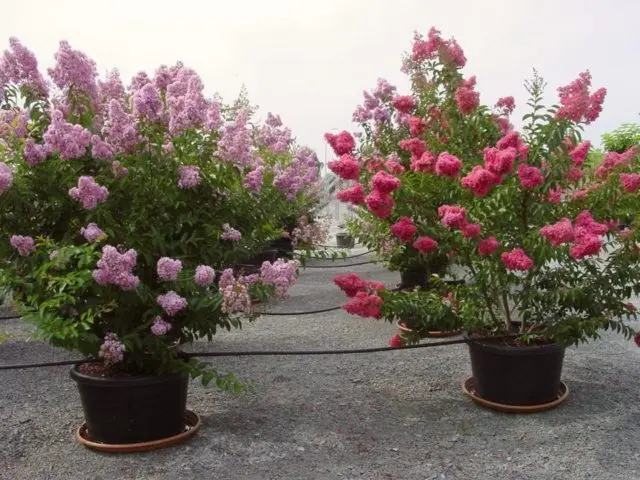
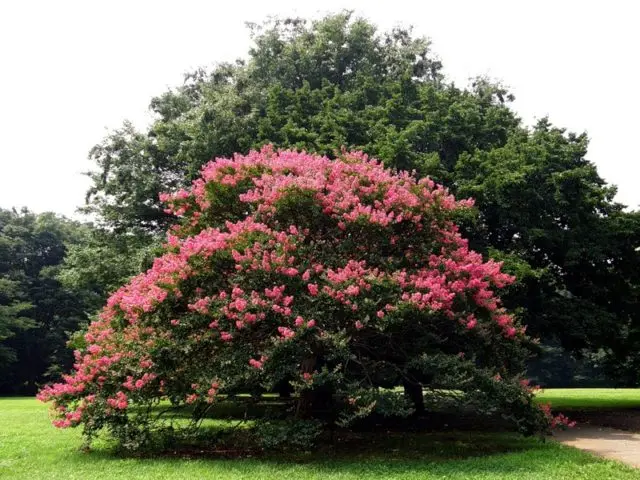
Conclusion
Indian lilac is a beautiful ornamental plant that can beautify any area. Its lush, long flowering pleases the eye throughout the warm season. Indoors, culture can also be successfully cultivated by placing an exotic tree on a loggia or veranda.










